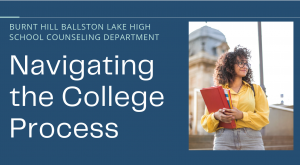College Information
The BH-BL Counseling Center is here to help students and parents navigate the college search and application process. There are many programs and events offered throughout the school year including two college fairs at the high school (representing almost 100 colleges), Financial Aid Night, individual college admission representative visits, and College Information Night. Please check the school calendar and the Counseling Center google classrooms for dates and times. Please contact your child’s counselor if you have questions, concerns, or would like set up a time to meet.
2025 College Information Night
On March 19th representatives from Siena College, RPI, and SUNY presented information about college admission, application process, and financial aid. If you were unable to attend you can review the presentation below. You are also welcome to contact your child’s counselor with any questions!
College Information Night Presentation
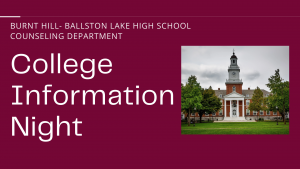
Navigating the College Process
THINGS TO CONSIDER – size of campus, number of students, distance from home, location (urban, suburban, rural), cost, athletics, graduation rates, academic competitiveness.
HOW MANY COLLEGES TO APPLY TO – A good number is between 5-10 colleges. These should be comprised of the following types of schools:
- SAFETY: 1 to 2 colleges You are likely to be admitted because your GPA and test scores far surpass the general admission criteria. Community colleges are often safety schools.
- TARGET: 3 to 6 colleges Your GPA, test scores, and academic rigor are what the college is looking for; you fall in the middle 50% of accepted students and you have a 50%-70% chance of being accepted.
- REACH: 1 to 2 colleges Your GPA, test scores, and academic rigor are not close to what the college is looking for in their average applicant. It is unlikely you will be accepted. Typical reach schools are colleges that accept 20% or less of students who apply.
College Application Information
- Direct to Institution Application – This is an application directly on the college’s website. It is usually a simple and streamlined application.
- The Common Application – Students can use applications that allow you to apply to multiple colleges with one application. Common Application is the most widely used college application system with over 900 member colleges and universities. www.commonapp.org
- SUNY Application – State University of New York, or SUNY schools utilize their own application system. However, many of the SUNY campuses also use the Common Application. You can use whatever application you prefer. www.suny.edu
- CUNY Application – City University of New York, or CUNY schools utilize their own application system for students who wish to apply to two and four year colleges in New York City. www.cuny.edu
- NAVIANCE – Whatever application you decide to use, you MUST also use naviance as part of the college application process. Naviance is how counselors send transcripts, letters of recommendation, and other required documents to the colleges you are applying to. Log into Naviance using your Clever Portal. See your counselor if you need help logging onto your account.
Early Decision, Early Action, Regular Decision, & Rolling Admission Programs
- Early Decision (ED) – students can apply ED to only ONE college. ED is a binding agreement; you and your parent will sign an ED contract stipulating that if accepted, you will attend and must withdraw all other college applications. The ED applicant pool is typically very small, giving you a better chance of acceptance. Application deadlines can be as early as Oct. 15, Nov. 1, Nov. 15, or Dec. 1.
- Early Action (EA) – students can apply to multiple colleges EA and are not required to commit to the college. EA applicant pool is also small, giving you a better chance of acceptance. Most students at BH-BL will utilize the EA admission program for at least one college. Application deadlines can be as early as Nov. 1, Nov. 15, or Dec. 1.
(Notes on ED & EA- Some colleges will offer both ED and EA programs while other will not offer any early admission programs at all. Some will only offer ED while others will only offer EA. Rarely, some colleges will offer a restricted EA program. Early admissions has both drawbacks and benefits. Be sure to read and understand the fine print!) - Regular Decision (RD) – regular decision is when most students will submit their applications. Deadlines are typically Jan. 1, Jan. 15, Feb. 1, Feb. 15, or Mar. 1.
- Rolling Admission (Roll) – colleges with rolling admissions accept applications at anytime during the admission process. They review and send decisions in 4 to 6 weeks of receiving the application. Even though there is no firm deadline, students are encouraged to submit their applications early as these colleges are filling their slots for their incoming freshman class throughout the admission cycle.
PSAT/NMSQT, SAT and ACT Information
- PSAT/NMSQT – High school students typically take the PSAT/NMSQT in Oct of grade 11. PSAT sign-ups take place in the Counseling Center in Sept/Oct. Sign-up info is posted on the daily announcements, google classroom, and on the Counseling Center portion of the district’s website.
- SAT/ACT – High school juniors typically take the SAT and/or ACT in spring of 11th grade. Exams are usually offered in March, April, May, and June. High school seniors can take, or retake, the SAT and/or ACT in fall of 12th grade. Exams are usually offered in Sept, Oct, Nov, and Dec.
Students MUST register themselves online for the SAT and ACT
- www.collegeboard.org
Visit CollegeBoard to register for the SAT, complete the CSS Profile Financial Application, send SAT scores to colleges you are applying to, and send AP Exam Scores to the college you will be attending. - www.act.org
Get information on ACT exams and register to take the test.
Many colleges have continued with the ‘test optional ‘policies and no longer require submission of standardized tests to be considered for admissions. Some test optional colleges may require SAT and/or ACT score for specific programs such as engineering, nursing, occupational therapy, pharmacy, or physical therapy. Be sure to check what the standardized testing requirements are for each college you are thinking of applying to.
2024 Test Optional College Information
Essay
Think of your college essay as a window – it allows the college admission counselor to look inside and discover who you really are and what you are about; to reveal the person behind the grades, resume, and activities. The college essay is your opportunity to paint a picture of yourself and a chance to share your story. College essays are usually 650-1000 words. Essays should be engaging, interesting, and well written. Be creative and use your own voice. Give specific examples of the attribute you are highlighting. A great essay takes time. Don’t expect to write it in a hour. It’s a process, so give yourself time to brainstorm, write, edit, revise, and repeat.
- College Essay Writing Tips and Information
- College Essay Writing Tips Video
- Essays that Worked: Connecticut College
- Essays that Worked: Hamilton College
Letters of Recommendation
- Teacher Letters of Recommendation – Teacher letters speak to you as a student in their classroom. Teachers will discuss your intellectual curiosity, creative thought, effort, attitude, and work habits. Always ask your teacher, in person, if they would be willing to write you a letter of recommendation in support of your application. Follow up with a handwritten thank you note.
- Counselor Letters of Recommendation – Counselor letters will focus on the whole person; the student, the teammate, the leader, the community member. Counselors will discuss your academic rigor, achievement, strengths, and struggles. They will also include information on your distinctive qualities, academic growth, areas of significant impact, and readiness for college.
Additional College Websites
- www.nycolleges.org
The page is sponsored by the Commission on Independent Colleges and Universities. - www.ctcl.org
Colleges That Change Lives was founded on a philosophy of introducing students to a personalized and transformative collegiate experience with a student-centered mission common to all member campuses. CTCL provides the opportunity to pursue a best-fit college to all students who ascribe to a similar philosophy and to help frame their college search beyond ratings and rankings. - www.fairtest.org
FairTest finds that more than 830 four-year colleges do not use the SAT or ACT to admit a substantial number of bachelor degree applicants. - www.mappingyourfuture.org
A great site for career and financial aid planning. - www.petersons.com
Finding your perfect college fit doesn’t need to be a major headache. We’ve compiled search tools for some of the best colleges and universities. - www.collegeconfidential.com
Here you’ll find hundreds of pages of articles about choosing a college, getting into the college you want, how to pay for it and much more. - www.allaboutcollege.com
Links to college and university homepages around the world that offer undergraduate programs. - Questions for College Representatives: Questions to ask about individual colleges.
- Affording College: Presented by the Commission on Independent Colleges and Universities.
College Planning Timeline
The BH-BL Counseling Center provides the following timeline to help both students and parents navigate through high school and get prepared for college.
Grade 9: Freshmen
Welcome to high school! Ninth grade is a time for exploration, so it’s important to do just that. Join clubs, athletic teams and get involved in other school activities. Volunteer! How else will you know what you’re good at or what you enjoy if you don’t try new things?
It’s also important to make sure you get off to a strong start in all your courses. Students who have to repeat classes close off their options and choices in coursework/internships, etc., down the road.
- December -January: Counselors meet with students for a classroom presentation about how to survive and thrive in ninth grade. Counselors will discuss three main areas of focus: Academic, Career, and Social Development. Students will use Naviance to take a Self-Discovery assessment, discuss academic skills, test their knowledge of graduation requirements, and explore careers!
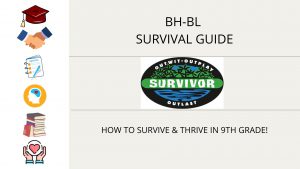
- March: Counselors will meet individually with students to review academic program and select courses for the next school year.
Grade 10: Sophomores
During your sophomore year, you’ll want to be watching for these things:
- October: Sophomores may be eligible to apply to several honor societies including Math, Science, and World Languages. Ask your teacher for information or contact the honor society advisors.
- November: Parents can attend the Financial Aid Program. Look for the date and time in the newsletter, school calendar, and on the district’s website.
- February-March: Counselors meet with each sophomore for their annual review. At this time, courses for 11th grade are selected, academic standing is reviewed and continued career exploration is encouraged.
- May: Counselors present to 10 graders The Real World – Burnt Hills program in classrooms. Students will complete the Career Interest Profiler on Naviance, select one career cluster from the results of the inventory and be assigned a career and salary in their area of interest. Students will get to pick where they want to live, what kind of car they want to drive, pay bills, and experience what it’s like to live in the real world! There are additional assessments for students to complete on Naviance including Career Cluster Finder and Strengths Explorer. Students can also complete a resume, review RoadTrip Nation, search for colleges, and much more! Naviance
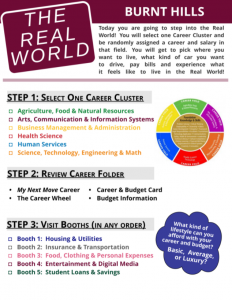
Grade 11: Juniors
Your junior year will be a challenging one in terms of academics. Most 11th-graders will take at least four key Regents exams at the end of the year (English, math, science, and social studies). It’s important to work hard and keep up in all your courses since your junior year academic record will impact—positively or negatively—your choice of colleges and scholarship opportunities next year.
- September-October: Sign up for and take the PSAT/NMSQT, a pretest for the SAT. Also, plan to meet with college representatives visiting BH-BL this fall. Check the Counseling Center google classroom for dates, times, and sign-up information. Be sure to sign up for the two college fairs offered at the high school. Over 100 colleges will be represented.
- October: Juniors may be eligible to apply to several honor societies including National Honor Society and the NYS Math, Science, and World Languages honor societies. Ask your teacher for information or contact the honor society advisors.
- November: Parents should attend the Financial Aid Program if they didn’t attend last year. Look for the date and time in the newsletter, school calendar, and on the district’s website.
- March: Parents and students should attend the College Information Night at the High School where they will hear presenters speak on topics including: Private 4 year college admissions, SUNY options, and financial aid.
- March-April: During this time, students should register for the SAT and/or ACT exams that are given in May and June. Students must register online. Consider taking an SAT prep course.
- Counselors will conduct individual junior meetings to discuss senior course selections, graduation requirements, career interests, activities, and plans for after high school. Parents are encouraged to contact their child’s counselor if they would like to attend this meeting.
- Counselors will also meet with 11th graders in classrooms to present College & Career Resources to help students develop a plan for after high school which may include college, military, or workforce.
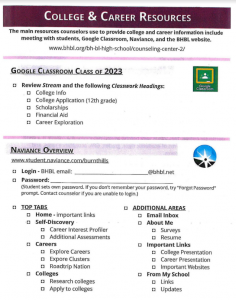
- May-June: Take the SAT, and/or ACT exam. The SAT or ACT may be required for admission to 4 year colleges. Exams should be taken during the spring of the student’s junior year.
- June-August: The summer before your senior year is a good time to visit colleges. Students should register online or call for an appointment first to avoid visiting a campus when it may be closed or between semesters. An interview with an admissions officer is advisable. Check out our tips for visiting colleges and a list of sample questions you can ask.
Summer is also a great time to volunteer in your community or attend a summer program. See Summer Programs in the Counseling Center Google Classroom for your class.
Grade 12: Seniors
Congratulations, you’re almost there! Your senior year will be an exciting one which, for most students, will be focused on making the smooth transition to college. In recent years, roughly 90 percent of BH-BL graduates plan to move straight on to either a two or four year college.
There’s a LOT to do this year, for parents and students alike, so take a deep breath and try not to get overwhelmed. Here’s a step-by-step checklist to keep you on track. Contact your school counselor if you need help!
September-October:
- Counseling Center Class of 2024 Google Classroom. Students should refer frequently to this classroom for information on college applications, scholarships, instant admission days, college fairs, college visits to BHBL, etc.
- Senior Conference. Each senior meets individually with their counselor to review graduation and course requirements and post-graduation plans including formalizing a college application timeline.
- Register for the SAT and/or ACT College Entrance Exams. A standardized test may be required for college admission. Most students take these exams during the spring of junior year and/or fall of senior year. Be sure to visit www.collegeboard.org (SAT) and/or www.act.org (ACT) to register for an exam.
- Meet with college representatives visiting BH-BL. The Counseling Center can tell you which schools will be visiting our district and when. Ask for a pass to visit with an admissions representative.
- Visit colleges. If you haven’t done this already, try to schedule some college visits this fall. Interview some students, faculty and staff if possible. It’s important to get a feel for the campus to see if it’s a good fit for you.
- Start your college application. Most schools use some form of online application, with many schools using Common Application.
- NAVIANCE – Whatever application you decide to use, you MUST also use naviance as part of the college application process. Naviance is how your transcript, teacher letters of recommendation, and other required documents are sent to the colleges you are applying to. See your counselor if you need help logging into your Naviance account.
- Essay – Most college applications require an essay. Get the topic and start writing it early. Try to make your essay compelling and be sure it reflects your best effort. Give it lots of thought, edit, spell-check and ask for feedback from an English teacher, counselor, parent, etc.
- Finalize your college choices. Decide on a minimum of three potential colleges. You should be thinking about some “reach” schools, “target” choices and a “safety” school. This pertains to academic, as well as financial, considerations.
- Request recommendation letters. NOW is the time to ask teachers, counselors, coaches, and employers for letters of recommendation related to school, your activities, and employment. These will be required for college applications. Ask for the recommendations in person. Be sure to write a thank-you note to each person who provides a recommendation.
- Try to finish your college applications by November. The earlier you apply, the better your chances of getting accepted. Even if the college’s official deadline is March 1, it’s better to get your application in by November. You’ll be ahead of the game and able to shift your focus to financial aid applications, scholarships and simply enjoying your senior year. Unless you thrive on stress, there is no good reason to wait until the last minute to begin working on college applications.
October:
- Apply for your FAFSA pin number and start gathering financial information. Virtually all colleges require the Free Application for Federal Student Aid form to apply for financial aid. Visit FAFSA on the Web at www.fafsa.ed.gov and sign up for your personal pin number if you’re going to submit the form online. This is also a good time to print out the worksheets for filling out the FAFSA so you’ll know what’s involved and can begin gathering the financial records. You can submit the FAFSA beginning October 1.
- Find out if colleges require the CSS/Financial Aid Profile. Some colleges (mostly private schools) require this special form, which is essentially a supplement to the FAFSA. The College Board website has a list of the schools that require it, but it’s always better to check with the college directly.
- Call financial aid offices to find out if they require any other special financial forms of their own. This is most common at private colleges. If they require specialized forms, ask them to mail them to you now.
November:
- College applications should be close to completion. You will need to see your counselor to request that an official high school transcript be sent to each college you are applying to. Please be sure to keep your Naviance account up to date as your counselor uses this site to submit your documents.
- Request official SAT/ACT scores from testing agency. You are responsible for having your scores sent to the colleges you are applying to. The scores will NOT be included on your high school transcript.
December:
- If you’re still applying to colleges, get those applications filled out and notify your counselor as soon as possible, allowing at least three weeks for processing. Keep in mind counselors are not in school during the Holiday Recess at the end of December. January 1 deadlines should be turned in to your counselor by December 1 at the latest.
- Parents: Save year-end payroll stubs that show your earnings for the year. You may need it for financial aid eligibility reviews by schools and to estimate your taxes on the FAFSA form.
- Start checking for scholarship applications. Check the Counseling Center google classroom frequently for scholarship announcements and application information. New scholarships come in at all different times during the year and they aren’t just for the “straight A” students. Scholarship Info
January:
- Get your income tax returns prepared early. Colleges may request them and you will need tax information to complete the FAFSA. Note: since some schools require the FAFSA by February 1, and many employers don’t give out W-2 forms until late in January, you can opt to estimate your taxes using the prior year’s tax returns and this year’s pay stubs. (See the FAFSA Web site for more details.)
- Complete the FAFSA form. Submit the forms. Some schools require it as early as February 1, but be sure to submit it no later than March 1. You improve your chances of receiving financial aid if you submit your forms early.
- Apply for outside funding and scholarships. Keep checking for scholarship applications on the Counseling Center google classroom every week and explore other sources. For example, parents might belong to organizations or work in businesses that award scholarships. Visit www.fastweb.com the internet’s largest free scholarship search. Look around.
February-March:
- Make sure your FAFSA is complete and has been submitted.
- Check on mid-year transcripts. Did you tell your counselor which colleges want mid-year transcripts? Stop in the counseling center and confirm that they were sent.
- Watch for your Student Aid Report (SAR). This is a one-page summary of the FAFSA information you submitted. It is sent to you to confirm the accuracy of all data one last time before it is forwarded to your colleges. Occasionally the SAR will note that information is missing or incomplete. In all cases, follow directions on the SAR and return it as quickly as possible. If you have not received your Student Aid Report within five weeks after sending in your FAFSA, contact the Federal Student Aid Information Center.
April:
- Watch the mail or email for college admission decisions. They typically start arriving in April. Notify your counselor of all admission decisions: acceptance, denial, waitlist, and/or deferral.
- Compare financial aid packages from each college.
- Make a decision. Which college you will attend and send them your formal acceptance and deposit. Be sure to notify your counselor of your decision!
May and beyond:
- Complete the Senior Destination Survey. This is how you will notify the Counseling Center what college you will be attending, if you are going into the military, training, or employment. ALL seniors must complete this survey by May 1.
- Final High School Transcripts. Final HS transcripts will be sent to the college you will be attending by the second week of July. If your plans or college changes over the summer, please contact the counseling center.
- If you will be participating in NCAA Division I & II athletics, AND have registered with the NCAA online, your final high school transcript will be sent to the NCAA online portal by the second week of July.
- Watch for important deadlines at your college of choice. These may include housing deposits, financial aid, orientation sessions, and more.
- Have a fun summer and good luck in college!


